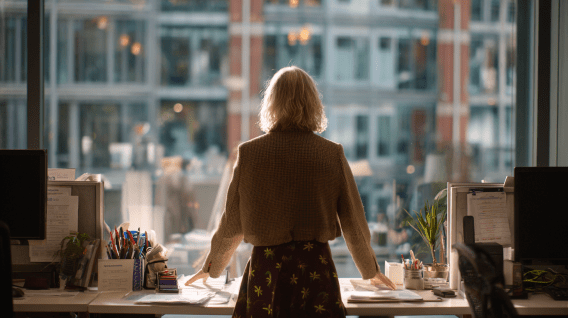Industry bodies confirm redundancy crisis is real as creative layoff rates double

Redundancy rates among ACA members rose to 11% (Midjourney)
The media and marketing industry has recognised the redundancy crisis hitting senior employees, with industry groups pointing to a number of factors combining to make this downturn different from the past.
Lower consumer confidence combined with a shift of resource allocation from headcount to AI investment in bigger companies are thought to be the main culprits.
Mumbrella sought the response of industry associations following the publication of an anecdotal survey of senior figures who had been made redundant this year.
In speaking with ten accomplished leaders who had lost jobs – with several still out of work or having shifted to other industries – Mumbrella hit a nerve.
Enjoying Mumbrella? Sign up for our free daily newsletter.
Advertising Council Australia (ACA) CEO Tony Hale told us in a written response that his latest salary survey data backed up the widely perceived redundancy increase, with the redundancy rates (in the yet-to-be-released 2025 survey) sitting at 11%, up to double the normal level.
“Without doubt, every company in Australia is reviewing its business model and operations, seeking efficiencies and automation to navigate global uncertainty, technological disruption, and shifting consumer media and consumption habits,” he said.
“Our members are not immune. ACA’s 2025 Salary Survey revealed a redundancy rate of 11%, compared to the usual range of 5–7%. I expect this trend to continue in the short term as businesses continue to restructure, but hopefully it begins to stabilise in the second half of 2026.”
Impact of ageism
Jacquie Alley, Independent Media Agencies of Australia (IMAA) chair and The Media Store chief operating officer, confirmed that it was senior employees in the crosshairs, and said ageism was a factor.
“Whilst periods of consolidation and growth have always been part of the media industry, this recent period of extraordinary volumes of redundancies does feel different,” she said in a written statement.
“Not only are they a manifestation of broader economic difficulties and corporate restructuring efforts happening across the Australian economy, we are seeing cuts affecting more senior positions as companies re-evaluate their organisational structures, ripping out senior salaries to improve profitability.
“What concerns us is that the industry is at serious risk of losing deep institutional and media knowledge and experience. And the sad reality of ageism is playing out as these senior people affected are facing serious hurdles as job seekers.”
Swapping people money for AI money
The Interactive Advertising Bureau (IAB) drew a nuanced picture in its statement, confirming the redundancy trend and pointing to “sharper focus on efficiency and productivity”, lower consumer confidence and structural change driven by AI.
“Where large global platforms once invested heavily in building teams, they are now prioritising capital expenditure in AI, data centres, and advanced computing,” IAB CEO Gai Leroy told Mumbrella.
“This cycle of contraction and reinvention isn’t new for our industry — but the pace of AI investment and globalisation means the shape of future teams will look quite different.”
Australian Association of National Advertisers (AANA) CEO Josh Faulks agreed that AI was one of the chief causes, describing it as “the greatest disruption of our time”, and likening it to the introduction of the internet and mobile phones.
“There’s no doubt quiet redundancies are happening in our industry, and many people are doing it tough. Being pulled from the workforce can take a real toll, including on mental health, and as an industry we need to support our people during this difficult time.”
Media Federation of Australia (MFA) CEO Sophie Madden brought a personal note.
“I know the pain of redundancy firsthand, the shame, the self-doubt, the worry it can bring,” she told Mumbrella.
“Our industry is undergoing significant transformation, and with that comes uncertainty – redundancies are, sadly, part of today’s working reality.”
But … there’s also hope
All the industry bodies contacted by Mumbrella noted the industry had experienced turbulent times in the past, and would adapt to the current situation. The AANA’s Josh Faulks said this:
“We adapted then, and we can do it again. How we navigate this transition matters: we need to support, retrain and retain talent where possible, but always balance it with commercial reality and a focus on sustainable growth.”
Industry association statements in full
Gai Leroy, CEO, IAB
There has undoubtedly been a shift in employment trends in the media and marketing industry in Australia and globally. On the media and tech side, while some mid-sized organisations and new start-ups have grown modestly, their headcounts haven’t offset losses from larger players. Many companies are also carefully managing resources through contractors, outsourcing, and offshoring.
A sharper focus on efficiency and productivity, combined with low consumer confidence, has led to cuts across both senior, higher-cost staff and reduced onboarding of entry-level employees. At the same time, structural changes driven by technology, AI, and an increasingly global media ecosystem are reshaping the industry. Where large global platforms once invested heavily in building teams, they are now prioritising capital expenditure in AI, data centres, and advanced computing.
This cycle of contraction and reinvention isn’t new for our industry — but the pace of AI investment and globalisation means the shape of future teams will look quite different. That said, ours is a resourceful industry. We’re seeing more marketers and entrepreneurs pivot into adjacent areas such as health and commerce tech, while senior leaders increasingly explore fractional opportunities to share their expertise more flexibly.
Tony Hale, CEO, ACA
Without doubt, every company in Australia is reviewing its business model and operations, seeking efficiencies and automation to navigate global uncertainty, technological disruption, and shifting consumer media and consumption habits. Our members are not immune. ACA’s 2025 Salary Survey revealed a redundancy rate of 11%, compared to the usual range of 5–7%. I expect this trend to continue in the short term as businesses continue to restructure, but hopefully it begins to stabilise in the second half of 2026.
Jacquie Alley, IMAA Chair and The Media Store chief operating officer
Whilst periods of consolidation and growth have always been part of the media industry, this recent period of extraordinary volumes of redundancies does feel different. Not only are they a manifestation of broader economic difficulties and corporate restructuring efforts happening across the Australian economy, we are seeing cuts affecting more senior positions as companies re-evaluate their organisational structures, ripping out senior salaries to improve profitability.
What concerns us is that the industry is at serious risk of losing deep institutional and media knowledge and experience. And the sad reality of ageism is playing out as these senior people affected are facing serious hurdles as job seekers. On a positive note, it is heartwarming to see the stigma of redundancy lose its shame as people bravely share their stories of grief, and re-discovery of self. This is new and much needed as the emotional toll of such an experience can’t be underestimated.
Whilst the indies aren’t immune to redundancies as we ride the wave of consolidation and growth as well, many of us can hold during periods of economic instability by pulling the cost levers required quickly. Furthermore, many owners have been known to take pay cuts themselves to stabilise their P&Ls and prioritise their people. Working in your business alongside your people makes the relationships very personal, and whilst I can’t speak for all our members, the common sentiment is that redundancies are the last lever to be pulled. Furthermore, there is a deep appreciation for experienced senior talent in our agencies, with 9% aged 50 years or older versus the global agency average of 5% (IMAA Salary Survey Sept 2024).
Overall, the health of the indie sector is strong. In our May 2025 Census, over 70% of our member agencies declared they will be increasing staff numbers in FY26 and 77% forecast an increase or flat FY26 in media spend. So, we head into Q4 optimistic but not complacent. There is a lot of disruption, and we are endeavouring to keep our members updated and equipped to face the challenges – and grab the opportunities – ahead.
To all those who’ve been affected by these recent redundancies, please lean on your media community. We are here to support you, connect you, and help you find pathways back into meaningful work. The skills, experience, and perspective you bring remain invaluable to this industry. Our sector has always been defined by creativity, resilience, and collaboration, and now more than ever we need to uphold those values to retain and nurture the incredible talent that has shaped Australian media. Change is inevitable, but isolation doesn’t need to be. Let’s continue to share stories, open doors, and ensure that no one is left behind as we navigate the realities and seize the possibilities that lie ahead.
Josh Faulks, CEO, AANA
There’s no doubt quiet redundancies are happening in our industry, and many people are doing it tough. Being pulled from the workforce can take a real toll, including on mental health, and as an industry we need to support our people during this difficult time.
AI is the greatest disruption of our time—reshaping marketing just as the internet and mobile once did. We adapted then, and we can do it again. How we navigate this transition matters: we need to support, retrain and retain talent where possible, but always balance it with commercial reality and a focus on sustainable growth.
Sophie Madden, CEO, MFA
I know the pain of redundancy firsthand, the shame, the self-doubt, the worry it can bring. Our industry is undergoing significant transformation, and with that comes uncertainty – redundancies are, sadly, part of today’s working reality.
What matters most is how we support one another as a community. One of the strengths of our industry is the way we rally around each other – perhaps because we’re a relatively small community, where so many of us have worked together at different stages.
When it comes to senior roles, the MFA’s position is clear: experience counts. The knowledge and perspective built over years in the industry add depth to decision-making, resilience in change, and vital mentorship for the next generation. That experience must be recognised and valued.


Told you Ai was coming 3 years ago.
Too bad no one listened